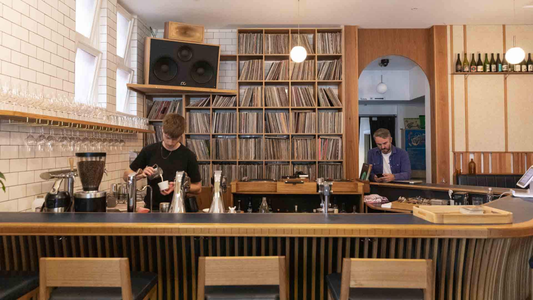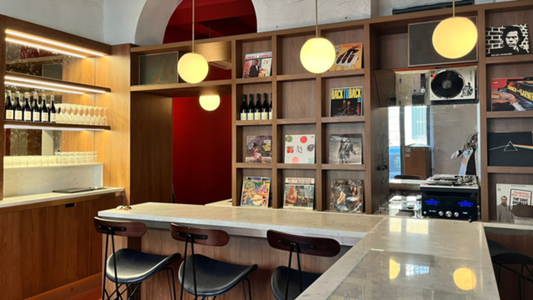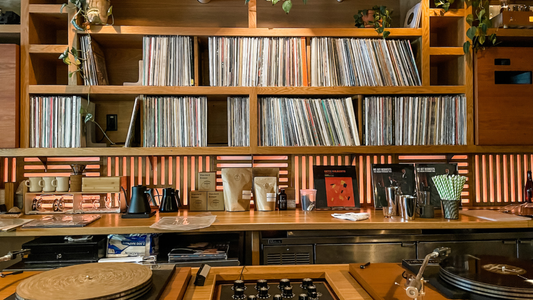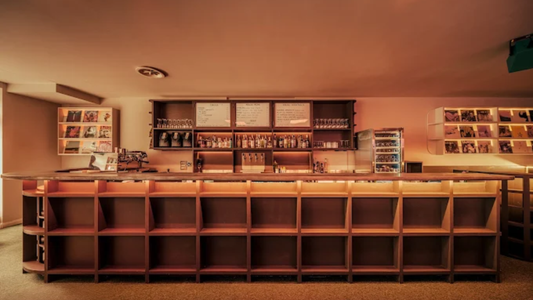
Silence is a Luxury — The Tracks & Tales Manifesto
By Rafi Mercer
The first time you walk into a room that has been tuned for listening, the air feels different. There is no clutter, no background chatter fighting for space, no nervous soundtrack to fill the silence. The noise of the street, the constant buzz of notifications, the mental static of daily life — all of it is left outside. What remains is an atmosphere of expectation, a reverence almost ecclesiastical. The quiet hum before a record begins. The pause before the stylus lowers. The silence that makes the music matter.
It is easy to forget how rare this has become. For centuries, music was scarce. It was something you sought out, invested in, and gave yourself to. You saved for a record, wore it down with repeated plays, lived with it in your room like a companion. Then, in the mid-90s, the world shifted. Napster arrived like a thief in the night — a digital bonfire on which the idea of scarcity was burned. Songs once treasured became packets of data, traded faster than they could be understood. Music was no longer hard-won; it was instant, everywhere, free.
The consequences were profound. Labels collapsed, artists suffered, and the craft of listening itself fractured. We moved from ritual to convenience, from leaning in to zoning out. What mattered was not quality but access. We stopped listening and started consuming.
Streaming polished the rough edges but deepened the habit. The world now carries entire libraries in its pockets, billions of tracks on tap. And yet, in this flood, something vital has been eroded. Songs are no longer moments of attention, but fragments of distraction. They drift past like notifications. They fill space but rarely shape it. Music has become wallpaper.
Tracks & Tales was born from the recognition of this loss. Not a nostalgia for vinyl alone, nor a fetish for analogue over digital, but a belief that experiences matter more than access. That the way we encounter music defines what it means to us. And that silence, the frame which gives sound its power, has become the rarest luxury in a noisy age.
The Japanese understood this long before the rest of us. In the post-war decades, kissaten cafés emerged in Tokyo, Osaka, and beyond. These were not mere coffee shops, but sanctuaries of sound. Walls lined with vinyl, turntables treated like altars, systems tuned with obsessive precision. Patrons did not come to talk over music but to submit to it. In these smoke-filled rooms, conversation was hushed, the needle drop was sacred, and albums were played from start to finish. The kissaten carved out a culture where listening was a craft, not a pastime.
What fascinates me is how Japan resisted the drift towards convenience. Even as CDs, MP3s, and streaming reshaped the global market, kissaten and their descendants — the listening bars of modern Tokyo — held their ground. They did not compromise silence for chatter, or quality for volume. Instead, they doubled down on the idea that music deserves architecture. That acoustics, interiors, and intention matter as much as the record itself.
Step into one of these bars today — JBS in Shibuya, Eagle in Yotsuya, Studio Mule — and you feel it instantly. The outside world is suspended. The room becomes a chamber where sound is the only architecture. Each detail, from the weight of the curtains to the glow of the lamps, conspires to slow you down. Here, silence frames the experience, and listening becomes an act of respect.
This is the spirit that Tracks & Tales seeks to carry forward. To build a guide, a movement, a constellation of places where music is not background but foreground. Where bars and cafés become sanctuaries of sound. Where the craft of listening is restored to its rightful dignity.
It is not about rejecting technology. Digital access is here to stay, and rightly so. What matters is balance. We have gained reach but lost depth, gained choice but lost focus. The task now is to reimagine spaces where the quality of sound, the design of the room, and the presence of silence create something richer than convenience ever could.
There is a deeper truth here too: the spaces we inhabit shape how we listen. A track played on tinny earbuds while rushing through a train station is not the same track as the one played on a finely tuned system in a dimly lit bar where you surrender to it fully. The notes may be identical, but the experience is not. Sound is spatial. It requires a room, a body, a silence around it. To hear is not just to register vibrations but to be reshaped by them.
And so, Tracks & Tales is more than a catalogue of venues. It is a call to rethink our relationship with music. To ask: what does it mean to listen in an age of noise? What does it mean to value silence, to curate attention, to treat sound as architecture rather than decoration?
In the end, this is not elitism. It is generosity. Everyone deserves to feel what it is like to hear music in its full presence — to sit in a room where silence holds the air, where the system reveals details you never knew existed, where an album becomes a landscape you inhabit rather than a track you skip. This is not about owning more but about experiencing better.
The world does not need another playlist to skim. It needs places where we are invited to listen differently. To slow down, step inside, and surrender to the geometry of sound.
Silence is a luxury. Listening is a craft. Together, they are the foundation on which Tracks & Tales rests — not simply a project, but a movement. A reminder that how we hear shapes who we are.
Rafi Mercer writes about the spaces where music matters. For more stories from Tracks & Tales, subscribe here, or click here to read more.







